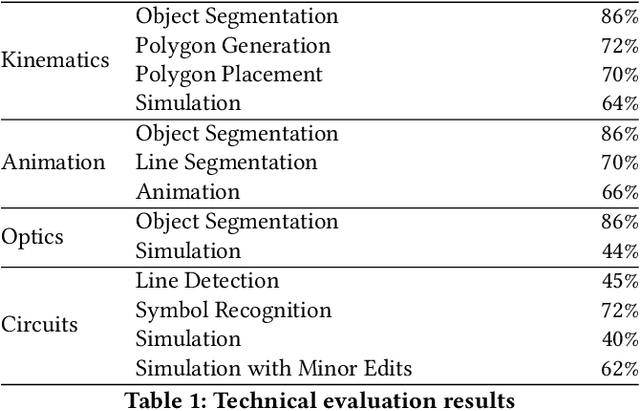Rubaiat Habib Kazi
Augmented Physics: A Machine Learning-Powered Tool for Creating Interactive Physics Simulations from Static Diagrams
May 28, 2024



Abstract:We introduce Augmented Physics, a machine learning-powered tool designed for creating interactive physics simulations from static textbook diagrams. Leveraging computer vision techniques, such as Segment Anything and OpenCV, our web-based system enables users to semi-automatically extract diagrams from physics textbooks and then generate interactive simulations based on the extracted content. These interactive diagrams are seamlessly integrated into scanned textbook pages, facilitating interactive and personalized learning experiences across various physics concepts, including gravity, optics, circuits, and kinematics. Drawing on an elicitation study with seven physics instructors, we explore four key augmentation techniques: 1) augmented experiments, 2) animated diagrams, 3) bi-directional manipulatives, and 4) parameter visualization. We evaluate our system through technical evaluation, a usability study (N=12), and expert interviews (N=12). The study findings suggest that our system can facilitate more engaging and personalized learning experiences in physics education.
DrawTalking: Building Interactive Worlds by Sketching and Speaking
Jan 11, 2024Abstract:We introduce an interactive approach, DrawTalking, in which the user builds interactive worlds by sketching and speaking. It emphasizes user control and flexibility, and gives programming-like capability without code. We implemented it on the iPad. An open-ended study shows the mechanics resonate and are applicable to many creative-exploratory use cases. We hope to inspire and inform research in future natural user-centered interfaces.
Automated Conversion of Music Videos into Lyric Videos
Aug 28, 2023Abstract:Musicians and fans often produce lyric videos, a form of music videos that showcase the song's lyrics, for their favorite songs. However, making such videos can be challenging and time-consuming as the lyrics need to be added in synchrony and visual harmony with the video. Informed by prior work and close examination of existing lyric videos, we propose a set of design guidelines to help creators make such videos. Our guidelines ensure the readability of the lyric text while maintaining a unified focus of attention. We instantiate these guidelines in a fully automated pipeline that converts an input music video into a lyric video. We demonstrate the robustness of our pipeline by generating lyric videos from a diverse range of input sources. A user study shows that lyric videos generated by our pipeline are effective in maintaining text readability and unifying the focus of attention.
RealityTalk: Real-Time Speech-Driven Augmented Presentation for AR Live Storytelling
Aug 12, 2022



Abstract:We present RealityTalk, a system that augments real-time live presentations with speech-driven interactive virtual elements. Augmented presentations leverage embedded visuals and animation for engaging and expressive storytelling. However, existing tools for live presentations often lack interactivity and improvisation, while creating such effects in video editing tools require significant time and expertise. RealityTalk enables users to create live augmented presentations with real-time speech-driven interactions. The user can interactively prompt, move, and manipulate graphical elements through real-time speech and supporting modalities. Based on our analysis of 177 existing video-edited augmented presentations, we propose a novel set of interaction techniques and then incorporated them into RealityTalk. We evaluate our tool from a presenter's perspective to demonstrate the effectiveness of our system.
 Add to Chrome
Add to Chrome Add to Firefox
Add to Firefox Add to Edge
Add to Edge